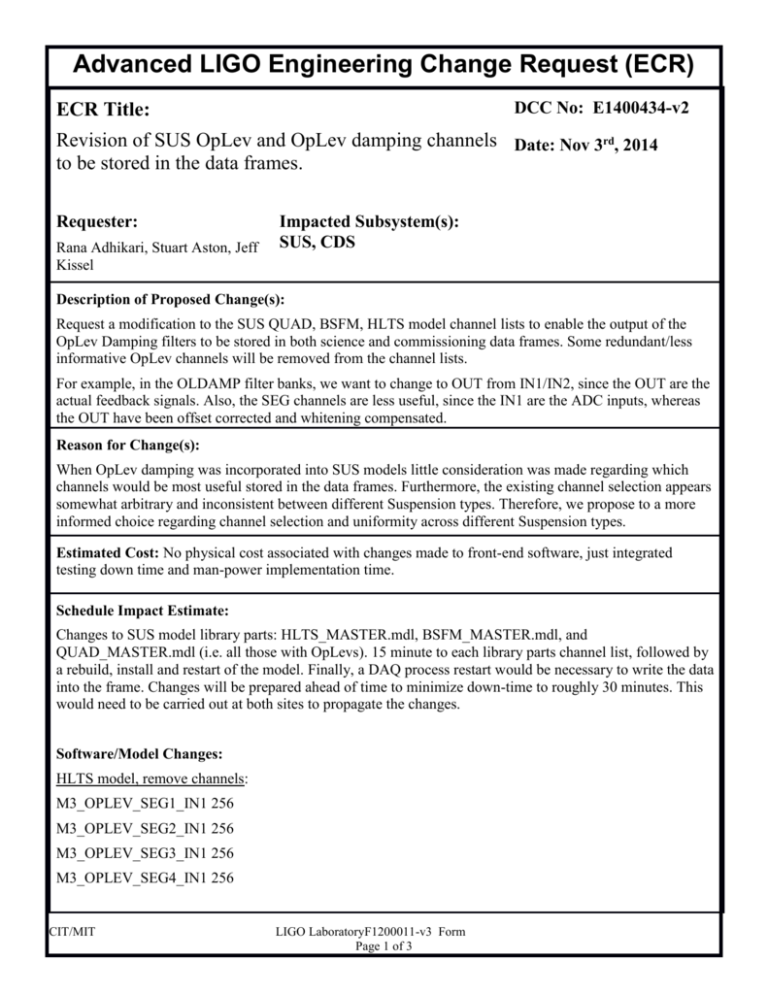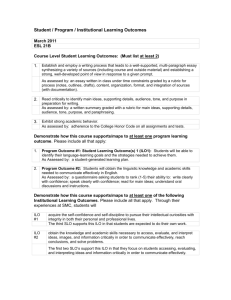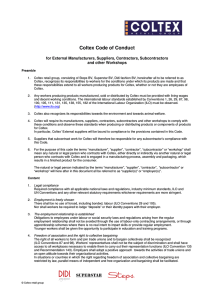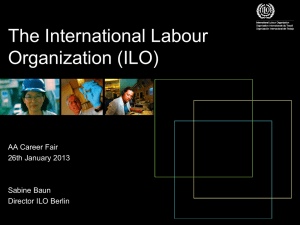E1400434 - DCC
advertisement

Advanced LIGO Engineering Change Request (ECR) DCC No: E1400434-v2 ECR Title: Revision of SUS OpLev and OpLev damping channels Date: Nov 3rd, 2014 to be stored in the data frames. Requester: Rana Adhikari, Stuart Aston, Jeff Kissel Impacted Subsystem(s): SUS, CDS Description of Proposed Change(s): Request a modification to the SUS QUAD, BSFM, HLTS model channel lists to enable the output of the OpLev Damping filters to be stored in both science and commissioning data frames. Some redundant/less informative OpLev channels will be removed from the channel lists. For example, in the OLDAMP filter banks, we want to change to OUT from IN1/IN2, since the OUT are the actual feedback signals. Also, the SEG channels are less useful, since the IN1 are the ADC inputs, whereas the OUT have been offset corrected and whitening compensated. Reason for Change(s): When OpLev damping was incorporated into SUS models little consideration was made regarding which channels would be most useful stored in the data frames. Furthermore, the existing channel selection appears somewhat arbitrary and inconsistent between different Suspension types. Therefore, we propose to a more informed choice regarding channel selection and uniformity across different Suspension types. Estimated Cost: No physical cost associated with changes made to front-end software, just integrated testing down time and man-power implementation time. Schedule Impact Estimate: Changes to SUS model library parts: HLTS_MASTER.mdl, BSFM_MASTER.mdl, and QUAD_MASTER.mdl (i.e. all those with OpLevs). 15 minute to each library parts channel list, followed by a rebuild, install and restart of the model. Finally, a DAQ process restart would be necessary to write the data into the frame. Changes will be prepared ahead of time to minimize down-time to roughly 30 minutes. This would need to be carried out at both sites to propagate the changes. Software/Model Changes: HLTS model, remove channels: M3_OPLEV_SEG1_IN1 256 M3_OPLEV_SEG2_IN1 256 M3_OPLEV_SEG3_IN1 256 M3_OPLEV_SEG4_IN1 256 CIT/MIT LIGO LaboratoryF1200011-v3 Form Page 1 of 3 Advanced LIGO Engineering Change Request (ECR) HLTS model, add channels: M3_OPLEV_SEG1_OUT* 256 M3_OLDAMP_P_OUT* 256 M3_OPLEV_SEG2_OUT* 256 M3_OLDAMP_Y_OUT* 256 M3_OPLEV_SEG3_OUT* 256 M2_OLDAMP_P_OUT* 256 M3_OPLEV_SEG4_OUT* 256 M2_OLDAMP_Y_OUT* 256 BSFM model, remove channels: M3_OPLEV_SEG1_IN1 256 M2_OLDAMP_P_IN1 256 M3_OPLEV_SEG2_IN1 256 M2_OLDAMP_Y_IN1 256 M3_OPLEV_SEG3_IN1 256 M2_OLDAMP_P_IN2 256 M3_OPLEV_SEG4_IN1 256 M2_OLDAMP_Y_IN2 256 BSFM model, add channels: M3_OPLEV_SEG1_OUT* 256 M2_OLDAMP_P_OUT* 256 M3_OPLEV_SEG2_OUT* 256 M2_OLDAMP_Y_OUT* 256 M3_OPLEV_SEG3_OUT* 256 M3_OPLEV_SEG4_OUT* 256 QUAD model, remove channels: L3_OPLEV_SEG1_IN1 256 L3_OPLEV_SEG2_IN1 256 L3_OPLEV_SEG3_IN1 256 L3_OPLEV_SEG4_IN1 256 QUAD model, add channels: L3_OPLEV_SEG1_OUT* 256 L2_OLDAMP_P_OUT* 256 L3_OPLEV_SEG2_OUT* 256 L2_OLDAMP_Y_OUT* 256 L3_OPLEV_SEG3_OUT* 256 L1_OLDAMP_P_OUT* 256 L3_OPLEV_SEG4_OUT* 256 L1_OLDAMP_P_OUT* 256 Net change = +22 channels -16 channels = +6 channels at 256 Hz data rate (*) denotes channel added to science frame as well as commissioning. CIT/MIT LIGO LaboratoryF1200011-v3 Form Page 2 of 3 Advanced LIGO Engineering Change Request (ECR) Nature of Change (check all that apply): Safety Correct Hardware Correct Documentation Importance: Improve Hardware Improve Software Improve/Clarify Documentation Change Interface Change Requirement Urgency: Desirable for ease of use, maintenance, safety Desirable for improved performance, reliability Essential for performance, reliability Essential for function Essential for safety Impacted Hardware (select all that apply): No urgency Desirable by date/event: ____________ Essential by date/event: ____________ Immediately (ASAP) Impacted Documentation (list all dwgs, design reports, test reports, specifications, etc.): Repair/Modify. List part & SNs: ______________________ Scrap & Replace. List part & SNs:_____________________ Installed units? List IFO, part & SNs: _________________ Future units to be built Disposition of the proposed change(s): The disposition of this proposed engineering change request is to be completed by Systems Engineering and indicated in the “Notes and Changes” metadata field in the DCC entry for this ECR. The typical dispositions are as follows: Additional Information Required: in which case the additional information requested is defined. The ECR requester then re-submits the ECR with the new information using the same DCC number for the ECR but with the next version number. Rejected: in which case the reason(s) for the rejection are to be given Approved Approved with Caveat(s): in which case the caveat(s) are listed TRB: the ECR is referred to an ad-hoc Technical Review Board for further evaluation and recommendation. It is the System Engineer’s (or designee’s) responsibility to organize the TRB. The System Engineer (or designee) then makes a technical decision based on the TRB’s recommendation. Links to the TRB’s documentation (charge, memos, final report, etc.) are to be added to the “Related Documents” field for this ECR. CCB: a change request for approval of additional funds or schedule impact is to be submitted to the Configuration Control Board. Links to the CCB’s documentation (CR, etc.) are to be added to the “Related Documents” field for this ECR. Concurrence by Project Management: Acknowledgement/acceptance/approval of the disposition is to be indicated by the electronic “signature” feature in the DCC entry for this ECR, by one the following personnel: Systems Scientist Systems Engineer Deputy Systems Engineer CIT/MIT LIGO LaboratoryF1200011-v3 Form Page 3 of 3








